NEC PA301w: The Baddest 30-inch Display Around
by Brian Klug on March 1, 2011 8:00 AM ESTViewing Angles
I almost don't need to say it, but the PA301w has superb viewing angles just as advertised. In both the horizontal and vertical directions, there's almost no distortion until viewed at the most extreme of angles. There's a bit more sensitivity in the vertical direction, but the difference is essentially insubstantial. Using the display in portrait is actually just an awesome testament to how good those viewing angles are - it's completely useable with no annoyances.
It's actually mind-blowing to use something this vertical to browse the net for even a few hours.
Color Quality
Next up are the ever-important color quality metrics. As usual, we report two main quality metrics: color accuracy (Delta-E) and color gamut. Color gamut refers to the range of colors the display is able to represent with respect to some color space. In this case, our reference is the AdobeRGB 1998 color space, which is larger than the sRGB color space. Our percentages are thus reported with respect to AdobeRGB 1998, and larger is generally better unless you're dealing with sRGB content and colorspace-unaware software.
Color accuracy (Delta E) refers to the display’s ability to display the correct color requested by the GPU and OS. The difference between the color represented by the display, and the color requested by the GPU is our Delta-E, and lower is better here. In practice, a Delta E under 1.0 is perfect - the chromatic sensitivity of the human eye is not great enough to distinguish a difference. Moving up, a Delta E of 2.0 or less is generally considered fit for use in a professional imaging environment - it isn’t perfect, but it’s hard to gauge the difference. Finally, Delta E of 4.0 and above is considered visible with the human eye. Of course, the big consideration here is frame of reference; unless you have another monitor or some print samples like a Gretag Macbeth color checker card to compare your display with, you might not notice.
As I mentioned in our earlier reviews, we’ve updated our display test bench. We’ve deprecated the Monaco Optix XR Pro colorimeter in favor of an Xrite i1D2 since there are no longer up-to-date drivers for modern platforms. We're trying to find an i1Pro to use as well.
For these tests, we calibrate the display and try to obtain the best Delta-E we can get at both 200 nits of brightness for normal use, and 100 nits for print brightness. We target D65 and a gamma of 2.2, but sometimes the best performance lies at native temperature and another gamma, so we try to find what absolute absolute best-case performance for each display. We also take an uncalibrated measurement to show performance out of the box using either the manufacturer supplied color profile, or a generic one with no LUT data. For all of these, dynamic contrast is disabled, and displays are left to settle for a half hour after making changes. The PA301w is CCFL-backlit, and I used a settle time of 30 minutes accordingly.
With the PA301w, I used the internal calibration routine to get me close, and then HCFR and the advanced OSD to get the color tristimulus primary values perfect. Then I calibrated with ColorEyes Display Pro.
First up is uncalibrated Delta-E performance. For this test, I took the monitor out of the box, connected it over DisplayPort, adjusted to 200 nits, and ran our usual GMB color checker test.
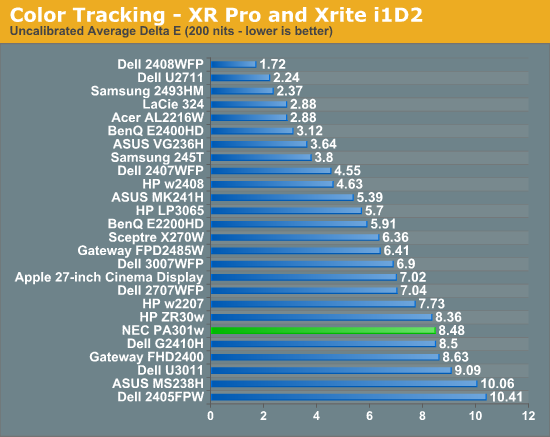
I took our uncalibrated test literally and ran this before using internal calibration either. Unsurprisingly, results aren't very good, and we see pretty middling performance out of the PA301w without any calibration. That said, if you're getting a professional monitor, you're hopefully going to calibrate it so you can actually enjoy what you're paying for. I didn't test, but running the in-monitor calibration alone has to help this out somewhat.
Moving on to the important 200 nit calibrated results, we can see the PA301w do very well, but still not displace the HP ZR30w result. I spent a lot of time trying to squeeze everything I could out of the PA301w and Delta E of 1.09 was as good as things would get. The result is still very good, I was just hoping to see something below 1.0 across the board like Jarred used to consistently. I'm beginning to suspect the i1D2 simply isn't as good of an instrument as the XR Pro, and what we're seeing is just instrumentational error creep in.
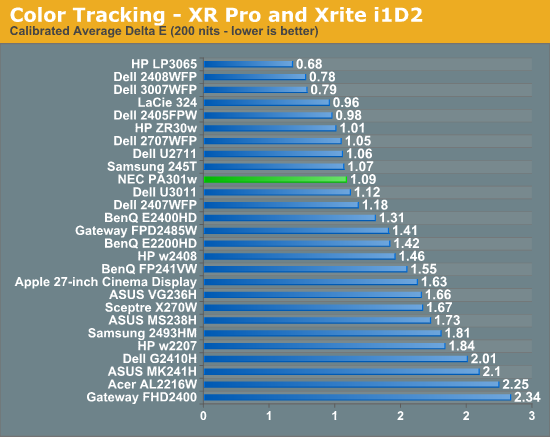
The PA301w doesn't have the typical spiky peaks that other displays which lack RGB controls show, which is great to see. You can see that the ZR30w still leads in some places, though the PA301w is clearly better in the greys.
At 100 nits, the PA301w pulls away and narrowly edges out the rest of the 30-inchers. Again, we still don't get a result that's under 1.0, but the numbers are obviously good enough for professional use.
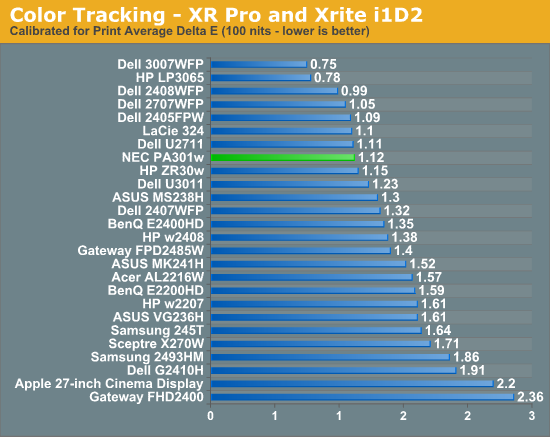
I'm impressed with color tracking on the PA301w and honestly think it can do better if we had an i1Pro spectroradiometer. I'm trying to get our hands on a good one, so we might just see it soon for these more serious display reviews.
Gamut percentage is important as well, and this is the only real place I think the U3011 has a distinct advantage. The PA301w has a "FULL" picture setting preset in the OSD which seems to change the red green and blue values to the edge of the display's supported gamut size. You can adjust further, however the labels turn pink which indicates that they're outside of the gamut. I went with full and took a reading, as expanding manually beyond didn't change the value any further. We can also see that the sRGB mode really clamps down on gamut percentage, and definitely works. There's also an AdobeRGB mode and a number of other common color spaces included. The PA301w uses an internal LUT to map color.
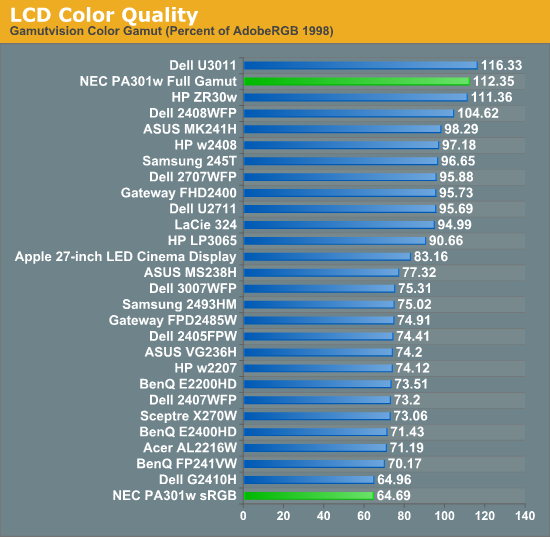









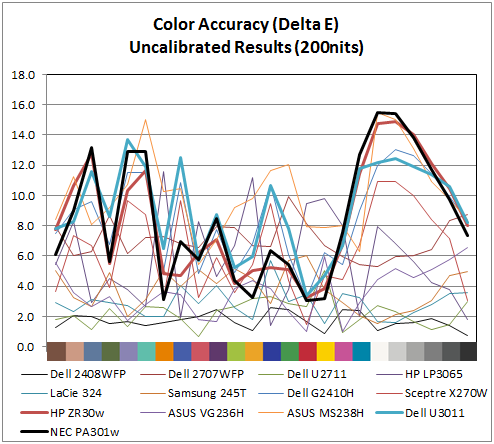
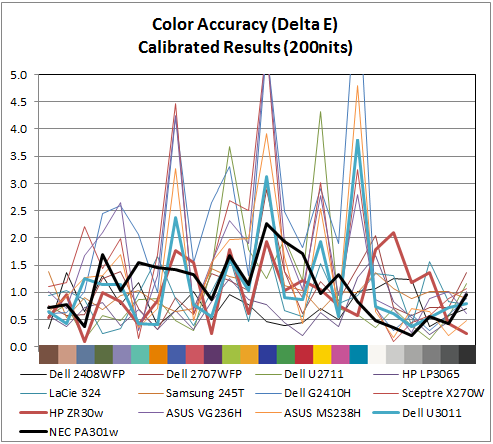









92 Comments
View All Comments
Lazlo Panaflex - Tuesday, March 1, 2011 - link
"It's seriously the Ron Jeremy of monitors if there were such a thing."Nah, more like John Holmes....
2 x this beast + AMD 6990 + Crysis2 = boner-rific
MeanBruce - Tuesday, March 1, 2011 - link
Done with the slow funk, so done with Dell out the f'in door end of the driveway pickup! Welcome those beautiful 30inches! ;)softdrinkviking - Tuesday, March 1, 2011 - link
Ryan,In there documentation, NEC claims that their calibrator is factory-tailored to NECs monitors, which seems to suggest that it is more than a "rebranding."
Of course, this could all just be marketing, and they could be the same thing.
Do you know for sure one way or the other?
softdrinkviking - Tuesday, March 1, 2011 - link
Oops. Brian. Not Ryan! Sorry... :)Ryan Smith - Wednesday, March 2, 2011 - link
It's okay. It happens all the time. ;-)Brian Klug - Tuesday, March 1, 2011 - link
From what I've seen, it really does look like a rebranded X-Rite i1D2. It's possible they've done some internal calibration as well (I know a few vendors do things like calibrate the colorimeter). It'd also make sense it's just rebranded since the i1D2 is the only thing that will work with internal monitor calibration.-Brian
eaw999 - Wednesday, March 2, 2011 - link
it's an i1d2 puck, but modified to allow proper calibration of wide gamut monitors.NEC_Art - Wednesday, March 2, 2011 - link
Yes, the NEC calibrator is tuned by X-Rite to more correctly read our MultiSync PA Series wide gamut displays. It is not the same as a retail i1 Display2.Art Marshall
Product Manager, NEC Display Solutions of America
peegeenyc - Tuesday, March 1, 2011 - link
can anyone find this for sale at a major discount retailer?It seems only NEC sell it at full price from my search results.
Azethoth - Tuesday, March 1, 2011 - link
"Apr 12, 2010 2:22 PM in response to: Zeno BokorRe: Photoshop 10bit support
Actually, the 10 bit/channel display path is working quite well in CS5 - on cards and displays that support it.
Again, we've been working with the manufacturers for a while to get it working..."
-Chris Cox (Photoshop lead)
I would be surprised if its the only software that handles 30bit